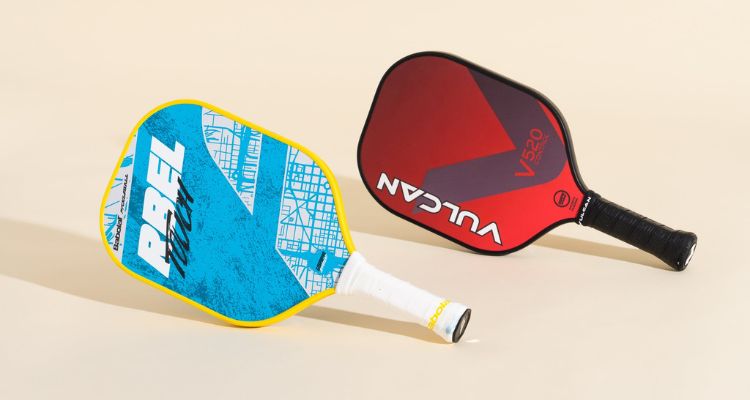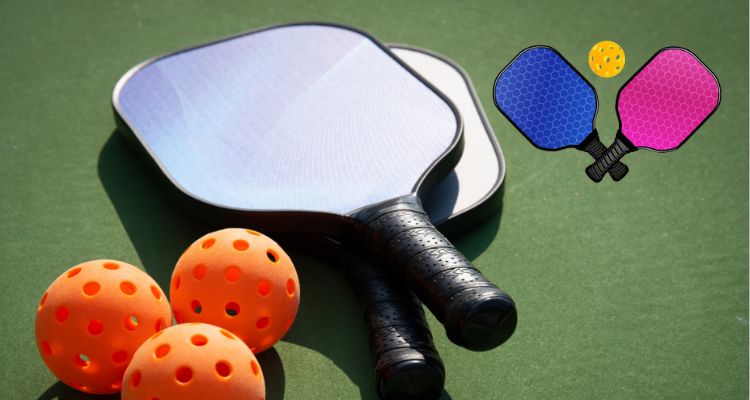Ready to up your pickleball game? It all starts with a good paddle. But not just any paddle will do. When it comes to pickleball, the type of paddle you choose can make all the difference. There are paddles made from different materials like wood, composite, polymer, fiberglass, and graphite.
In this article, we’re going to dive into the world of graphite pickleball paddles – some of the most popular and best-selling paddles on the market. We’ll explore their pros and cons, so you can decide if they’re the right fit for you.

The Pros of Graphite Pickleball Paddles
Graphite pickleball paddles come with a host of advantages that make them a top choice for many players. Here are a few of their pros:
- Lightweight: These paddles are usually lighter than other types, weighing between 6 and 8 ounces on average. The lightweight design makes them easier to maneuver and swing, especially if you’re a beginner or a senior player. Plus, a lighter paddle can reduce arm fatigue and prevent injuries.
- Durable and Resistant to Wear and Tear: Graphite is a strong and resilient material that can handle a lot of impact and pressure. The honeycomb core and thin layer of graphite give these paddles a solid structure and smooth surface. You can expect them to last for years without losing their shape or performance.
- Great Grip: The textured surface of graphite paddles provides more friction and grip on the ball. This translates to better control, accuracy, and the ability to generate more spin and slice. If finesse and touch are your style, graphite paddles are ideal.
- Suitable for All Skill Levels: No matter if you’re a beginner looking for something easy to use or an advanced player seeking a responsive and powerful paddle, graphite paddles can accommodate your needs. They’re versatile and customizable with different shapes, sizes, weights, and grips.
Now that you know the pros, let’s explore the cons of graphite pickleball paddles.
The Cons of Graphite Pickleball Paddles
As with anything, graphite pickleball paddles have a few downsides to consider:

- Expensive Compared to Other Materials: Graphite is a high-quality material, and that comes with a higher price tag. You can expect to pay anywhere from $50 to $200 or more for a graphite paddle, depending on the brand and features.
- Less Spin and Texture Than Fiberglass or Polymer Paddles: While graphite paddles offer good grip on the ball, they can’t match the spin and texture that fiberglass or polymer paddles provide. The rougher surface of fiberglass and polymer generates more friction, resulting in more spin and curve on the ball.
- Prone to Cracking or Chipping if Mishandled: Graphite is durable, but it’s also brittle. Mishandling or dropping your paddle can lead to cracks or chips. Additionally, hitting hard objects or surfaces like metal posts or concrete floors can damage the graphite. Be sure to handle your paddle with care and store it in a protective case when not in use.
- Less Power and Pop Than Composite or Wood Paddles: While graphite paddles are light and responsive, they may lack the power and pop of composite or wood paddles. Composite and wood paddles are heavier and stiffer, giving them more force and momentum behind each shot. Graphite paddles may fall short when it comes to speed and distance.
FAQs
Is the Chainsaw Serve considered legal in official pickleball tournaments?
While the official rulebook of the USA Pickleball Association (USAPA) does not explicitly label the Chainsaw Serve as illegal, its use has sparked debate among players. In tournaments, the decision may rely on referees or line judges, but players must navigate the fine line between creativity and adhering to the spirit of the game.
How does the Chainsaw Serve impact the dynamics of pickleball rallies?
The Chainsaw Serve, with its unique rolling and spinning motion, can catch opponents off guard, leading to unpredictable ball trajectories. This has resulted in shortened rallies, reduced enjoyment for some players, and heightened emotions on the court. The article explores both perspectives on whether it enhances the game or disrupts its core principles.
What are pickleball players saying about the Chainsaw Serve?
Opinions among pickleball players vary widely regarding the Chainsaw Serve. Some see it as an exciting evolution of the game, adding skill and thrill, while others perceive it as detrimental to fair play. The article features real player sentiments and comments, reflecting the ongoing debate within the pickleball community.
In Conclusion
So, are graphite pickleball paddles the right choice for you? They offer a lightweight, durable, grippy, and versatile option that can suit any skill level or playing style. However, they do come with a higher cost, lower spin potential, fragility, and less power compared to other materials. Ultimately, the best pickleball paddle for you depends on your personal preference, budget, and goals. We recommend trying out different paddles to see how they feel and perform for you.
We hope this article has provided you with valuable insights into the pros and cons of graphite pickleball paddles, helping you make an informed decision on your paddle choice. Happy Pickleballing!



